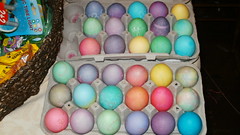Dying Easter eggs is a great activity to share with the kids, just prepare ahead to prevent messes. You don’t have to buy the special egg dye kits in the supermarket, instead use the food colorings that you already have in your kitchen cupboard or try some of these natural methods to dye eggs.
How to Dye Eggs

Protect All Surfaces
Cover your table with plastic, then add another layer of newspaper. Wear old clothes that you don’t mind getting dyed and think about wearing gloves if you don’t want multi-colored hands.
You Need:
- Hard Boiled Eggs
- Plastic Table Cloth
- Newspaper
- Bowls or Cups
- Food Coloring or natural coloring materials
- Vinegar
- Spoons
- Paper Towels
- Colander or Egg Tray
How to Dye With Food Dye
- Add 1 teaspoon of vinegar to 1 cup of boiling water. Add food coloring by the drop until the water is a deep shade of the desired color. You want the colors strong, they will be lighter on the egg
- Dip the hard-boiled eggs into the coloring with a spoon and let them soak. The color darkens as the egg soaks. Remove the egg when the color is your desired shade. Place them on paper towels to dry.
- Create patterns on the eggs before dying by wrapping them with rubber bands or string, or drawing on them with wax crayons. You can create multi-colored eggs by dipping eggs in several colors, soaking only part of the egg at each time.
Dying Eggs with Natural Foods
- You can also use the natural colors found in foods to color eggs. Simmer the colored plant or vegetable in water until the water is colored.
- Strain the water and add 2 to 3 teaspoons of white vinegar for each cup of colored juice.
- Soak the eggs as before. Some colors may require long soaking times, so keep them in the refrigerator while soaking.
Try these colors:
- Red or Pink: Beet juice, cranberry juice, cherry juice, raspberry juice and pomegranate juice.
- Yellow or Gold: Tumeric
- Orange: Carrots or paprika
- Green: Spinach
- You can also use herbal teas and flowers. Experiment and have fun.
Creating Natural Patterns
Interesting patterns can also be created by applying leaves or flowers directly to the egg before boiling. Start with raw eggs and place the leaves directly against the egg. Hold them in position with a layer of cheese cloth tied tightly around the egg. Boil them for 10 to 12 minutes. Drain the eggs and allow them to cool. Remove the cheesecloth and leaves to reveal your natural patterned eggs.
Tie-Dyed Eggs
- Fill a small bowl or cup half full with white vinegar. Dip hard-boiled eggs into the vinegar, turning it to coat the egg.
- Place the colander or egg carton on several layers of newspaper to absorb spills.
- Drop food coloring onto the egg, letting the colors run together as desired. For best results, start with lighter colors.
- Use a toothpick or small brush to move the color around on the egg as desired. Kids might enjoy blowing the drops of color around with a well-aimed straw. You don’t have to cover the entire egg, leave a little white space.
- Let each color set for a minute before adding the next color, then let the eggs dry before handling them. You can rinse off extra color or blot it off with a paper towel.
- Gently rinse the excess dye off of the eggs and place them on a paper towel to air dry.

